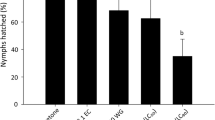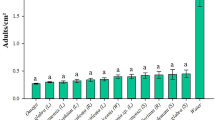Abstract
Toxicity and repellent activities of aqueous extracts of nine medicinal plants were evaluated on different life stages of the sweet potato whitefly, Bemisia tabaci. Tomato plants infested with whiteflies were dipped in 10% (wt/wt) of each plant extract for toxicity evaluation. Repellency was evaluated in a choice experiment with detached tomato leaves. All extracts evaluated were relatively ineffective against the adult stage. Extracts of Ruta chalepensis, Peganum harmala and Alkanna strigosa were effective in reducing the numbers of B. tabaci immatures similar to the reduction observed in the imidacloprid treatment. These three extracts were not detrimental B. tabaci parasitoid, Eretmocerus mundus. In addition, the plant extracts Urtica pilulifera and T. capita were repellent to B. tabaci adults. These results indicate that the extracts from the plants R. chalepensis, P. harmala and A. strigosa could act as a potential source for natural product developed for B. tabaci management.
Similar content being viewed by others
References
Abbassi K, Atay-Kadiri Z, Ghaout S (2003) Biological effects of alkaloids extracted from three plants of Moroccan arid areas on the desert locust. Physiol Entomol 28:232–236
Abbott WS (1925) A method of computing the effectiveness of an insecticide. J Econ Entomol 18:265–267
Ali-Shtayeh MS, Yaniv Z, Mahajna J (2000) Ethnobotanical survey in the Palestinian area: a classification of the healing potential of medicinal plants. J Ethnopharma 73:221–232
Avery PB, Faull J, Simmonds MSJ (2004) Effect of different photoperiods on the growth, infectivity and colonization of Trinidadian strains of Paecilomyces fumosoroseus on the greenhouse whitefly, Trialeurodes vaporariorum, using a glass slide bioassay. J Insect Sci 4:38–48
Barney JN, Hay AG, Weston LA (2005) Isolation and characterization of allelopathic volatiles from mugwort (Artemisia vulgaris). J Chem Ecol 31:247–265
Curtis CF (1990) Traditional use of repellents. In: Curtis CF (ed) Appropriate technology in vector control. CRC Press, Boca Raton, p 81
Gennadius P (1989) Disease of tobacco plantation in the trikonia. The aleurodid of tobacco. Ellenike Geogia 5:1–3
Georges K, Jayaprakasam B, Dalavoy SS, Nair MG (2007) Pest-managing activities of plant extracts and anthraquinones from Cassia nigricans from Burkina Faso. Bioresour Technol. doi:10.1016/j.biortech.2007.02.049
Hadis M, Lulu M, Mekonnen Y, Asfaw T (2003) Field trials on the repellent activity of four plant products against mainly Mansonia population in western Ethiopia. Phytother Res 17:202–205
Heywood VH, Harborne JR, Turner BL (1977) The biology and chemistry of the compositae. Academic Press, London
Immaraju JA (1998) The commercial use of Azadirachtin and its integration into pest control programs. Pestic Sci 54:285–289
Isman MB (2006) Botanical insecticides, deterrents, and repellents in modern agricultural and an increasingly regulated world. Annu Rev Entomol 51:45–56
Jbilou R, Ennabili A, Sayah F (2006) Insecticidal activity of four medicinal plant extracts against Tribolium castaneum (Herbst) (Coleoptera: Tenebrionidae). Afr J Biotech 5:936–940
Jovanovic Z, Kostic M, Popovic Z (2007) Grain-protective properties of herbal extracts against the bean weevil Acanthoscelides obtectus Say. Ind Crop Prod 26:100–104
Mancebo F, Hilje L, Mora GA, Castro VH, Salazar R (2001) Biological activity of Ruta chalepensis (Rutaceae) and Sechium pittieri (Cucurbitaceae) extracts on Hypsipyla grandella (Lepidoptera: Pyralidae) larvae. Rev Biol Trop 49:501–508
Mckenzie CL, Weathersbee AA, Puterka GJ (2005) Toxicity of sucrose octanoate to egg, nymphal, and adult Bemisia tabaci (Hemiptera: Aleyrodidae) using a novel plant-based bioassay. J Econ Entomol 98:1242–1247
Oliveira MRV, Henneberry TJ, Anderson P (2001) History, current status, and collaborative research projects for Bemisia tabaci. Crop Prot 20:709–723
Palumbo JC, Horowitz AR, Prabhaker N (2001) Insecticidal control and resistance management for Bemisia tabaci. Crop Prot 20:739–765
Park B, Choi W, Kim J, Kim K, Lee S (2005) Monoterpenes from thyme (Thymus vulgaris) as potential mosquito repellent. J Am Mosquito Cont Assoc 21:80–87
Regnault-Roger C (1997) The potential of botanical essential oils for insect pest control. Integ Pest Manag Rev 2:25–34
SAS Institute (2002) SAS/STAT user’s guide, version 9. SAS Institute, Cary
Spafford Jacob H, Jardine A, Carver S, Tarala K, Van Wees M, Weinstein P (2007) Laboratory determination of efficacy of a Santalum spicatum extract for mosquito control. J Am Mosquito Cont Assoc 23:304–311
Thoeming G, Borgemeister C, Setamou M, Poehling HM (2003) Systemic Effects of Neem on Western Flower Thrips, Frankliniella occidentalis (Thysanoptera: Thripidae). J Econ Entomol 96:817–825
Urbaneja A, Sánchez E, Stansly P (2007) Life history of Eretmocerus mundus, a parasitoid of Bemisia tabaci, on tomato and sweet pepper. BioControl 52:25–39
Acknowledgments
This research was supported by the Deanship of Scientific Research, Al Balqa’ Applied University. We thank Ebtisam Al-awamleh for her help in the research work.
Author information
Authors and Affiliations
Corresponding author
Additional information
Communicated by C. Cutler.
Rights and permissions
About this article
Cite this article
Al-mazra’awi, M.S., Ateyyat, M. Insecticidal and repellent activities of medicinal plant extracts against the sweet potato whitefly, Bemisia tabaci (Hom.: Aleyrodidae) and its parasitoid Eretmocerus mundus (Hym.: Aphelinidae). J Pest Sci 82, 149–154 (2009). https://doi.org/10.1007/s10340-008-0233-x
Received:
Revised:
Accepted:
Published:
Issue Date:
DOI: https://doi.org/10.1007/s10340-008-0233-x




